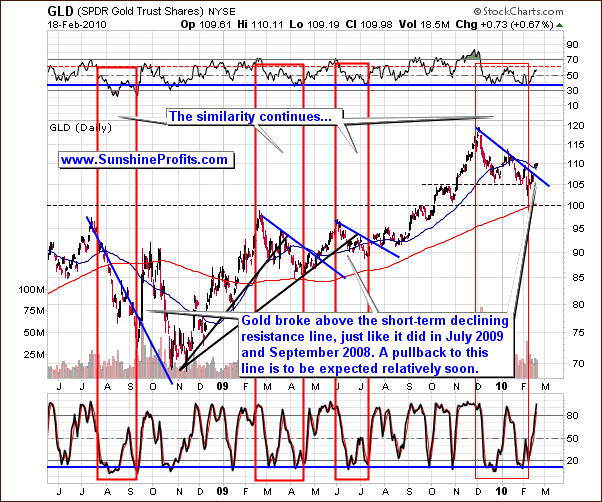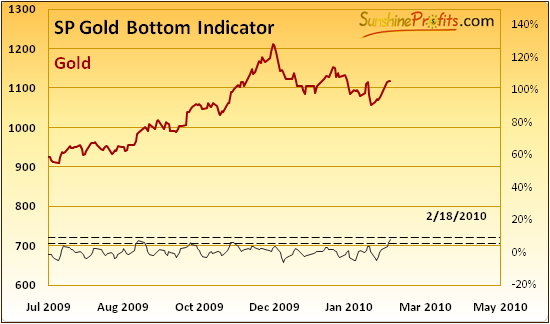This essay is based on the Premium Update posted on February 19th, 2010. Visit our archives for more gold articles.
Investing your money in a long-term position can be likened to navigating a ship to port. The compass (fundamental and technical analysis) points you in the right direction as you head out to sea. Even if your ship is sturdy (you have made the right call and are heading in the right direction) every once in a while a big, unexpected wave seems to push you off course.
And without question, since the beginning of the economic crisis, the seas have become especially turbulent.
One such wave was the announcement this Wednesday by the IMF that it would begin phased open-market sales of the remaining 191.3 tons of gold it plans to sell under a program launched last year to raise money for lending. The price of gold dropped 1 percent on the news.
To remind you, this comes nearly four months after India purchased 200 tons from the IMF, news that helped push the price of gold up. So what is the difference?
The IMF had announced last year that it would sell 403.3 tons of gold, about one-eighth of its total stock. Until now, the gold has been made available only to central banks on a first-come-first-serve basis. So far, India -- the world's biggest consumer of gold -- Mauritius and Sri Lanka have purchased a total of 212 tons of IMF gold. The average price for the three sales was a little over $1,050 an ounce, generating about $7.2 billion in proceeds.
In a carefully worded press release, the IMF said that "in accordance with the priority of avoiding disruption of the gold market, the on-market sales will be conducted in a phased manner over time."
The press release further noted that this does not preclude off-market sales directly to interested central banks.
It is well known that China is interested in increasing its gold reserves. China is sitting on top of a huge mountain of dollar reserves. In fact, a day before the IMF announcement, the US Treasury Department released data showing that Japan overtook China to become the world's biggest foreign holder of U.S. Treasury debt, reclaiming the title for the first time in more than a year. China shed more than $34 billion in long-and-short-term Treasury debt in December, while Japan added $11.5 billion, according to the monthly Treasury International Capital report.
So, it wouldn't surprise anyone if China steps in and buys some of the IMF gold. Perhaps, as was mentioned in last week's Premium Update, China is waiting for a better price.
We believe that the IMF announcement will have a negligible effect on the long-term price of gold. The IMF said it would stagger the sales. But even if it were to dump all the tons at once, it seems that they would be almost immediately absorbed by China, Russia, Middle Eastern sovereign funds and other central banks.
In this case, it seems that we don't need a confirmation that gold is still a very-long-term buy in the form of the news that George Soros charged into gold during the fourth quarter even despite the fact that gold prices had already run up substantially. He doubled the stake of his fund in the world's largest gold ETF, becoming the fourth- largest holder in the SPDR Gold Trust. As of December 31, gold is Soros's largest single investment.
Moving back to the analogy from the beginning of this update - we have set our course and we will keep a close eye on the charts to get us safely to port. This week, we prepared two charts for you - one featuring gold, and the second one with one of our unique indicators. Let's begin with the gold market (charts courtesy of http://stockcharts.com.)

In the previous essay we wrote the following:
(...) we see that the similarity that was present during the latest decline is still present after gold bottomed. This time, however, it suggests that gold may soon need to consolidate for a week or so - just like it took place in the past. Please take a look at the areas marked with red rectangles - gold paused when it moved to the declining short-term resistance line (April 2009), or it broke above it and then verified it as support (October 2008, July 2009). Should history repeat once again, we can see a similar pattern also this time (...)
These comments are up-to-date also this week, only this time we already know that gold moved above the declining resistance line, just like it did in July 2009 and September 2008. This means that gold may need to form a temporary top here, which would take gold lower, most likely to the $105 - $107 area in the GLD ETF.
Is gold likely to have topped right now? Not necessarily, based on the situation in the RSI indicator. In the past this particular indicator needed to move to the level marked with the dashed red line before the temporary top was in. Currently, the RSI indicator is visibly below it, so we may see additional several days of higher prices before gold declines significantly.
The Stochastic indicator is above the 80 level, just like it was the case in the past during local tops, but it has also stayed there for some time before the top has been put, so it is a necessary factor, but not sufficient one. In other words, if Stochastic wasn't above 80 level, we would be reluctant to say that we may see a temporary top soon, but since it is above 80 it doesn't mean that the top is in.
Given the historical performance of the yellow metal, we might expect the consecutive decline to be rather small (the preceding downswing is not even close to being as dramatic as the 2008 one), so it seems that it is not much of an opportunity for shorting the precious metals market, unless we see a confirmation that general stock market's decline can cause PMs to plunge.
The last chart that we would like to feature this week is the one featuring one of our own indicators - the SP Gold Bottom Indicator.

According to its name, the above indicator provides buy signals for gold. The buy signal is given, when indicator breaks down lower dashed line, or when it breaks up through the upper dashed line. Since it has just moved above the lower line, it means that it will move below it sooner or later, most likely during the coming small correction, thus generating a buy signal.
Summing up, the precious metals market has moved higher, and it appears that it will need to take a small breather relatively soon. Gold, silver, and PM stocks are currently following the general stock market more closely than the follow the USD Index. This is a positive factor in the very-short-term (main stock indices are rising), but negative in the long run because the situation on the general stock market is still bearish from the long-term point of view.
Meanwhile, one of our unique indicators is about to flash a buy signal. This is positive news for the whole precious metals market, not only for gold itself, but we still need to monitor the situation on the general stock market and check how gold corresponds. Several days of divergence between PMs and the main stock indices will most likely be enough to let us know that PMs are ready to rise once again. For now, we must remain cautious. Naturally, we will keep our Subscribers updated.
To make sure that you are notified once the new features are implemented, and get immediate access to my free thoughts on the market, including information not available publicly, I urge you to sign up for my free e-mail list. Sign up today and you'll also get free, 7-day access to the Premium Sections on my website, including valuable tools and charts dedicated to serious PM Investors and Speculators. It's free and you may unsubscribe at any time.
Thank you for reading. Have a great weekend and profitable week!
P. Radomski
--
This week's Premium Update includes over 5000 words and 12 charts dedicated to the the current situation from the point of view of the Precious Metals Investor. The issues that we covered this week include:
- The IMF announcement about the plans to sell the remaining 191.3 tons of gold
- Yesterday's interest rate increase (what does it mean for PM Investors?)
- Are the gold-producing juniors also likely to move lower with the main stock indices?
- Who should buy gold now, and who can wait?
- Correlations between PMs, main stock indices, and the USD Index
- Long- and shor-term charts of gold, silver, PM stocks, USD, SPY ETF with short-term price targets
- Cyclical tendencies, our own unique indicator, divergences, and much more...
We encourage you to Subscribe to the Premium Service today and read the full version of this week's analysis right away.

